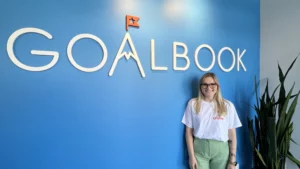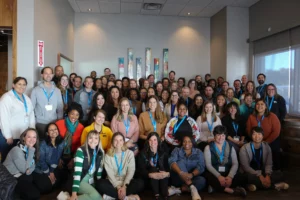If you’re an educator or former educator, and you’re starting to consider making the move to EdTech, you may feel unsure exactly where to start. Looking for and applying to jobs in EdTech is very different from looking for jobs in education: what works for applying to education jobs does not always work when applying to EdTech jobs.
I met with Purva Dandona, one of Goalbook’s recruiters and a former educator, to get some suggestions and insider information to help create a plan for those who are looking for a job in EdTech but don’t really know where to start. Let’s face it, educators are really good at creating lesson plans every day for their students, but you may feel a little lost when making a plan for yourself, especially when it comes to transitioning to a new industry like EdTech. We’re here with a three step plan to help you make the move to EdTech.
Step 1: Research
If you’re truly considering transitioning to working in the EdTech sector, take the time to research what you want to do and where you hope to work so that you’re maximizing your strengths and opportunities.
“Researching roles and companies is a critical step often overlooked by educators or former educators,” says Dandona. “When you don’t take the time to really hone in on what you want to do or what company will be a good fit for you, you end up applying to any and all jobs at an EdTech company. By doing this, you’re showing you don’t truly understand the EdTech space.”
We’ll break this important step into two parts: 1) research what roles suit you best, and 2) research what company you think would be a good fit.
- Research What Role Suits You Best.
Considering a new role is a big deal, and it can feel very overwhelming. Dandona says, “It’s so important to not apply for just any job that you find and think you like. Doing this will create a lot of work for yourself, and it can also lead to job-search burn-out.”
To help you better understand some of the roles in EdTech, check out our article “What Roles Exist at EdTech Companies?”
- Research What Company You Think Would Be a Good Fit.
Knowing what roles exist in the EdTech sector is one thing; knowing what EdTech companies exist is another. How will you know what kind of company you want to work for and that will be a good fit for you?
“Although education and EdTech are related industries, they are quite different,” says Dandona. “One way to begin the process of researching companies is to think about all the EdTech products you currently use (or used) and liked while teaching. You can also consider EdTech companies in your field of expertise or interest.”
Look these companies up on LinkedIn, and begin to follow them. Companies often post job openings and other news, so you’ll be able to see what’s available and also get a feel for the pulse of what the company stands for and is all about. Other places to research a company are Glassdoor, company blogs, or other social media sites. Be sure to know what the company actually does.
Taking the time to research roles and companies up front can save you time and effort later because it will give you a clearer idea of what you want to do in your next role and how you want to go about getting that role.
Step 2: Network
Sometimes in education, it may feel like your only network is the one that is in your school building or maybe even your district. Your network may begin within your school or district, but it doesn’t have to be limited by them.
Dandona has the following tips for networking beyond a physical building:
- Let People Know.
Now this may be tricky if you’re still teaching. “There can be a lot of fear in looking for another job. We understand how scary it can be to talk to other people about it,” says Dandona. “Especially if you’re talking to others at your school or within your district.”
Take some time to think about who you know and who wants to see you succeed. You may need to think outside the box of your professional network. Think about family members, friends who work in other industries, or other people in your community. They may know someone who knows someone who can help point you in the right direction. Make a list and try to reach out to 1–3 people a week.
- Reach Out to People Who Are in Positions You Want.
LinkedIn is a place for people to make professional connections and to build their professional network. But this doesn’t mean that when you find a company you’re interested in on LinkedIn, you should reach out to everyone who works there to request connections.
If you do contact someone at a company that you’re interested in, be considerate in asking for their time or even in requesting answers to questions. “If possible, try to find someone at the company besides the recruiter as recruiters get inundated with requests,” Dandona states.
Dandona also wants to encourage you if a connection you wanted to make doesn’t work out. “Putting yourself out there and trying to make connections is a brave thing to do, so you may feel discouraged if the connection you hoped for doesn’t come through. Try to remember that it isn’t personal,” Dandona says.
If you have tried twice to reach out to someone without success, it might be best to let it go and find someone else in your network.
For more ideas and suggestions for networking via LinkedIn, check out the following articles from various publications: LinkedIn, Forbes, and Career Higher.
Step 3: Take Action
After you’ve done some research into roles and companies and have begun to build your network, it’s time to take action.
- Update Your Cover Letter and Resume.
Doing the research in Step 1 first will save you time in this step because once you figure out what role you think best suits you, you can tailor your cover letter and resume for that job type.
Dandona says, “Narrowing down to a couple of roles allows you to have a more specific resume and saves you in two ways: 1) you’ll save time by not rewriting or reworking your resume for every job you apply for, and 2) you’re not using a generic resume.”
The same is true for your cover letter. Dandona recommends updating it for each job you apply for, highlighting why you would be a good fit for the company.
If you use the same generic resume and cover letter for every job you apply to, it shows recruiters or hiring managers that you may not fully understand what the role is or who the company is.
- Apply with Intention.
Most educators entered the field because they want to make a difference or because they’re mission-centered individuals. We strongly suggest that you keep that part of you in the front of your mind as you’re applying for jobs.
“It is natural to feel a sense of urgency or desperation when you’re wanting to change careers, but don’t let those feelings overwhelm you or dictate your actions. Instead, apply with intention,” says Dandona.
This can mean setting an intention for the week, such as: “For this week, I will research two companies and apply to them if I think they suit me.”
Applying with intention can also mean applying only for roles and companies that align to your personal experience, strengths, and mission. An intention for this could be: “I’ve found four companies I am interested in and that have roles that speak to my strengths. This week I will turn in applications to two of those companies.”
Be sure to track your intentions for the week.
When you apply with intention, you can save yourself time and effort because you’re avoiding submitting multiple applications without a specific purpose in mind, hoping something will work out by chance.
For more guidance on Step 3: Take Action, take a look at our article “How to Prepare for Your EdTech Job Application Journey — Insights and Suggestions from an EdTech Recruiter.”
Ultimately, we know deciding to leave one career for another is a big decision that is potentially life-changing. We encourage you to be patient. Be patient with others. Be patient with yourself. And be patient with the process.
It is a crazy job market out there, so be sure to take care of yourself during the job search.
— — —
Explore Goalbook’s open jobs on our Careers Page.
Follow us on LinkedIn to stay up to date on job opportunities.
Read stories about the Culture at Goalbook.





